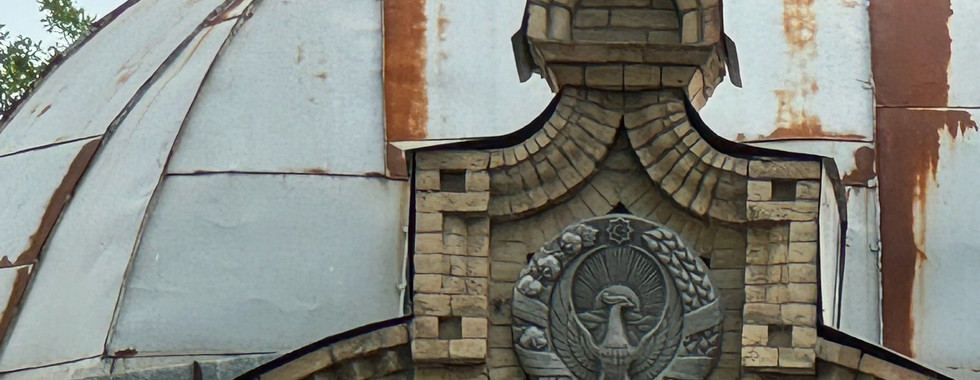Journey to the East|From conquest to empire to soviet state to peace从征服到帝国,从苏维埃到和平的转变
- Ole Bouman
- Apr 28, 2024
- 4 min read
I had to spend several days in the Uzbek capital Tashkent, anxiously awaiting the return of my bicycle from the chaos at Dubai airport (see previous blog). But this wait has given me the opportunity to reflect on Tashkent’s unique position—not only as a historical nexus between East and West on the Silk Road, alongside cities like Samarkand, Bukhara, Merv, Khiva, and Urgench, but also in its contemporary role as capital of a country trying to reinvent itself. Uzbekistan is squeezed by changing climates, aspiring peoples, political ambitions, and global powers, all recognizing its strategic importance yet leaving the Uzbeks to demonstrate their self-esteem, creativity, and agility. And they do with surprising sophistication, at least to me.
我在乌兹别克斯坦首都塔什干度过了几天,焦急地等待从迪拜机场混乱中运回我的自行车(详情见之前的博客)。这段等待期让我有机会深入思考塔什干的独特地位——它不仅是丝绸之路上东西方的历史交汇点,与撒马尔罕、布哈拉、梅尔夫、希瓦和乌尔根奇等城市并肩,同时也是一个努力重塑自身的国家首都。乌兹别克斯坦受到气候变化、人民抱负、政治野心和全球势力的挤压,所有这些都凸显了其战略重要性,也给乌兹别克人带来了展示自己自尊、创造力和灵活性的机会。至少在我看来,他们以令人惊讶的程度实现了这一点。
During this unexpected stop, I’ve explored the city’s monuments and urban layout, impressed by its balance of urban fabric, infrastructure and parks, focused on well-being and keen historical awareness. Like many architects visiting Tashkent, I downloaded the Tashkent Modernism app, which offers a comprehensive look at the modernist structures from when Uzbekistan was part of the Soviet Republic. Notable changes, like the Lenin memorial now serving as the National Museum, reflect a shift from universal principles to national pride. This adaptability is mirrored in other architectural highlights featured in the app, such as the towering former Russia Hotel, now the Uzbekistan Hotel, set against the backdrop of a monumental equestrian statue of Amir Temur, a brutal descendant of Genghis Khan in the 14th century, who made it the status of national hero for Uzbekistan today.
在这次意外停留期间,我游览了城市的纪念碑和布局,对其城市结构、基础设施与公园的和谐平衡印象深刻,这些设计都注重居民福祉和历史意识。如同许多造访塔什干的建筑师一般,我下载了塔什干现代主义app,该应用详细介绍了乌兹别克斯坦作为苏联一部分时期的现代主义建筑。例如,原列宁纪念碑现在改为国家博物馆,这种变化反映了从普遍价值观向国家自豪感的转变。这种适应能力也体现在app中提到的其他建筑亮点上,比如原来的俄罗斯酒店现在成为乌兹别克斯坦酒店,酒店前是阿米尔·帖木尔的雄伟骑马雕像,他是14世纪成吉思汗的后代,如今被尊为乌兹别克斯坦的国家英雄。
Hosted and introduced by the emerging Uzbek architect Ranay Utkelbayeva, I had the opportunity to deliver a lecture to students, all around 19 to 20 years old, who could articulate in detail the challenges of Uzbekistan's central dependency—sharing resources like rivers, forests, deserts, and railroads with neighboring countries. With my Amsterdam-Shanghai route displayed, we discussed the potential cultural narratives that this 'middle zone' might embody, as envisioned by the younger generation.
在乌兹别克斯坦新兴建筑师拉奈·乌特克尔巴耶娃的主持和引介下,我有幸为一群19至20岁的学生们做一场讲座。这些学生详细地讨论了乌兹别克斯坦作为中心的依赖性挑战,比如与邻国共享河流、森林、沙漠和铁路等资源。在展示了我从阿姆斯特丹到上海的路线图时,我们探讨了这个“中间地带”可能蕴含的潜在文化叙事,正如年轻一代所设想的。
One such narrative was vividly presented at the National Museum through an extensive photo series featuring the current President Shavkat Mirziyoyev with various powerful state leaders. Although the presentation was somewhat static, it underscored the nation's orientation towards peace, a refreshing perspective after my abrupt departure from Iran, that not only faced an immediate threat the night I left, but also for decades already is facing the effects of slow and encroaching effects of economical sanctions.
在乌兹别克斯坦的国家博物馆,通过一系列展示当前总统沙夫卡特·米尔济约耶夫与各国权力领袖会晤的照片,生动地呈现了这样一个叙事:尽管这种展示方式略显静态,但它强调了国家致力于和平的方向。这在我从伊朗突然离开后显得尤为新鲜——我离开的那个晚上,伊朗不仅面临着迫在眉睫的威胁,而且几十年来一直承受着经济制裁缓的持续影响。
This journey increasingly shapes my view of peace not merely as a pathway to progress but as essential for survival. In a world ticking down to climatic catastrophe, each day marred by aggression is a day lost.
这段旅程越来越让我认识到,和平不仅仅是通往进步的道路,更是生存的基石。在全球气候灾难的倒计时中,每一个被侵略破坏的日子都是失去的一天。
Journey to be continued...
and to follow the Journey by
Instagram:@Olebouman
Linkedin:@Olebouman
Facebook:@Olebouman
Youtube: @Journey to the East
Linktree: https://linktr.ee/olebouman
Weibo:@Olebouman




























































Comments